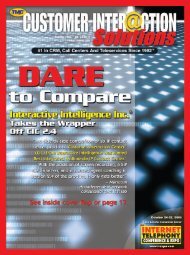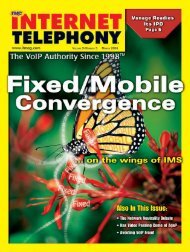service provider news - TMC's Digital Magazine Issues
service provider news - TMC's Digital Magazine Issues
service provider news - TMC's Digital Magazine Issues
- No tags were found...
Create successful ePaper yourself
Turn your PDF publications into a flip-book with our unique Google optimized e-Paper software.
Ask the SIP Trunk ExpertBy Steven JohnsonUnified Communications: Microsoft Lync and SIP TrunkingThis month at ITEXPO, our speakers atthe SIP Trunk-Unified CommunicationsSummit are addressing the key issues youneed to know to leverage SIP, SIP trunks and unified communicationsto help your business succeed. One of the hottesttopics is Microsoft Lync 2010.Like Microsoft Office Communications Server 2007, whichhas a tremendous installed base of users employing OCS SIPbasedcommunications, Microsoft Lync 2010 is not expectedto be natively compatible with SIP trunking.Why? Microsoft OCS and Lync have several requirements whendeploying SIP trunking. First is the use of TCP transport. TheTCP transport, as compared to UDP transport, provides a morereliable means of communication between <strong>service</strong>s and can beeffective in unified communications. However, many SIP trunk<strong>service</strong> <strong>provider</strong>s deploy SIP trunking only using the UDP transport(referred to as a streaming protocol, as data is sent withoutconfirmation or receipt/delivery, whereas TCP is sent in small segmentsand confirmation is sent before the next segment is sent).Another common OCS and Lync requirement is the use offully qualified domain names in many to all of the SIP addressingfields. Again, many SIP trunk <strong>service</strong> <strong>provider</strong>s deploy SIPtrunks using only IP addresses in the SIP addressing fields.Enterprise session border controllers, or E-SBCs, can solvethis problem. They sit at the edge of the network to providecontrol over the SIP traffic. Traditionally they were seen as justproviding firewalling protection – the security – for SIP-basedvoice networks. Today’s E-SBCs provide that security, whichis absolutely a critical function, and have evolved to serve as acrucial element in enabling SIP deployments.E-SBCs can provide a seamless format conversion of TCP toUDP, and change IPs to FQDNs, working hand-in-hand withthe ITSP <strong>service</strong> and Microsoft Lync 2010 solution.Stop by the free SIP Trunk-UC Summit at ITEXPO, which includesa full day focused on unified communications, and get thelatest from the experts and visionaries in the field. ITSteven Johnson is president of Ingate Systems (www.ingate.com).E911 WatchBy Nick MaierSIP and E911...It’s About TimeTwo recent announcements from voiceplatform vendors prove the industry is gettingserious about addressing the E911 issue for SIP endpoints.The first announcement from Microsoft was ablockbuster. With the launch of the new Microsoft LyncUnified Communications platform, SIP endpoints canrequest and hold their location within the enterprisenetwork as an object and, when a user dials 911, thelocation object is sent with the call to emergencydispatchers. This is the first commercial implementationof the National Emergency Number Association’s i3standard, which calls for endpoints to know their locationso that it can be sent with the voice call in the event of a911 emergency. Pretty cool.The second announcement came from Avaya with the launchof its Avaya Aura Session Manager Release 6.1. With SessionManager 6.1, a SIP endpoint registers with Session Manager,and the IP and MAC address of the endpoint are sent to athird-party application that can query the network to findthe exact location of the phone. The third-party softwarethen writes instructions back to the call server that tells ithow to route a 911 call. Session Manager 6.1 brings AvayaSIP endpoint capabilities in line with those Avaya H.323endpoints now enjoy.These two announcements testify to the importanceenterprises place on E911 capabilities. Enterprise customersexpect robust E911 capabilities for all endpoints includingSIP phones. In fact, many of these customers pushed backon voice platform <strong>provider</strong>s that launched SIP endpointswithout E911, essentially saying: “We can’t move forwardwith SIP until E911 is automated as part of the solution.”Thankfully, the platform <strong>provider</strong>s seem to have gottenthe message. ITNick Maier is senior vice president of RedSky Technologies(www.redskyE911.com).GoTo:16 INTERNET TELEPHONY ® February 2011 Subscribe FREE online at www.itmag.comTable of Contents • Ad IndexGoTo:









